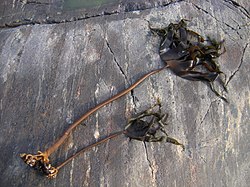Brown algae
Brown algae are a large group of multicellular algae. All the brown algae are multicellular. Most brown algae have fucoxanthin, a chemical that gives them a brown color. They include many seaweeds in colder waters of the Northern Hemisphere. Most brown algae live in marine environments, where they play an important role both as food and as a potential habitat.
| Brown algae Temporal range: Jurassic to present
| |
|---|---|

| |
| Giant kelp (Macrocystis pyrifera) | |
| Scientific classification | |
| Domain: | |
| Kingdom: | |
| Division: | |
| Class: | Phaeophyceae |
| Orders | |
|
see Classification. | |
| Synonyms | |
|
Fucophyceae | |
There are 2000 species of brown algae. Most species live in the ocean. They are important as food and as homes for many animals and marine life. Some brown algae are gathered by humans for food. The giant kelp Macrocystis is a brown alga that forms underwater forests, and it may grow to 60 meters. The Sargasso Sea gets its name from the Sargassum seaweed that floats on the surface. Many brown algae grow on rocks at the seashore.
Brown algae are unique among heterokonts in developing into multicellular forms with differentiated tissues. But they reproduce by means of flagellated spores and gametes that look like the cells of other heterokonts. Genetic studies show their closest relatives to be the yellow-green algae (Xanthophyceae).
Classification
This is a list of the orders in the class Phaeophyceae:[2]
|
|
+{{{1}}}−{{{2}}}
Brown Algae Media
Two specimens of Laminaria hyperborea, each showing the rootlike holdfast at lower left, a divided blade at upper right, and a stemlike stipe connecting the blade to the holdfast.
Species like Fucus vesiculosus produce numerous gas-filled pneumatocysts (air bladders) to increase buoyancy.
Growth in Dictyota dichotoma occurs at each frond tip, where new cells are produced.
Saccharina latissima on a beach.
References
- ↑ Kjellman, F. R. (1891). "Phaeophyceae (Fucoideae)". In Engler, A.; Prantl, K. (eds.). Die natürlichen Pflanzenfamilien. Vol. 1. Leipzig: Wilhelm Engelmann. pp. 176–192.
- ↑ Guiry, M. D.; Guiary, G. M. (2009). "AlgaeBase". National University of Ireland. Retrieved 2012-12-31.
+{{{1}}}−{{{2}}}
| Wikispecies has information on: Phaeophyceae. |
| Wikimedia Commons has media related to Lua error in Module:Commons_link at line 62: attempt to index field 'wikibase' (a nil value).. |
+{{{1}}}−{{{2}}}




